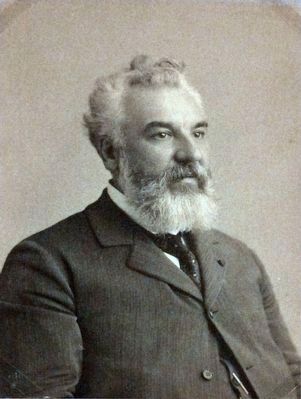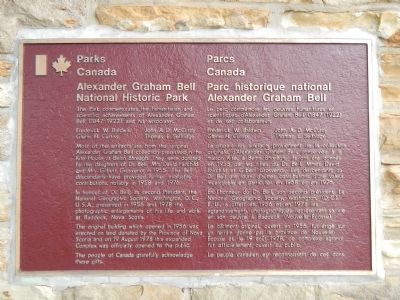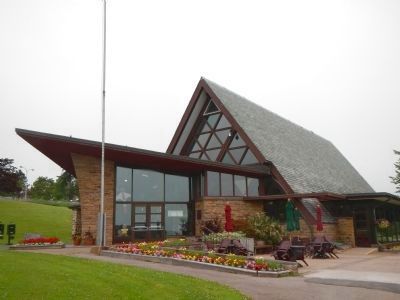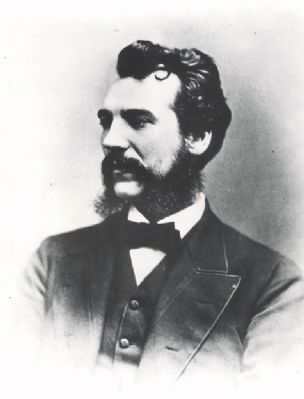Baddeck in Victoria County, Nova Scotia — The Atlantic Provinces (North America)
Alexander Graham Bell National Historic Park
Parc historique national Alexander Graham Bell
Inscription.
English:
The Park commemorates the humanitarian and scientific achievements of Alexander Graham Bell (1847-1922) and his associates
Most of the artifacts are from the original Alexander Graham Bell collection preserved in the Kite House at Beinn Bhreagh. They were donated by the daughters of Dr. Bell: Mrs David Fairchild and Mrs. Gilbert Grosvenor in 1955. The Bell descendants have provided further invaluable contributions, notably in 1958 and 1976.
In honour of Dr. Bell, its second President, the National Geographic Society, Washington, D.C., U.S.A., presented enlargements of his life and work at Baddeck, Nova Scotia.
The original building which opened in 1956 was erected on land donated by the Province of Nova Scotia and on 19 August 1978 this expanded Complex was officially opened to the public.
The people of Canada gratefully acknowledge these gifts.
French:
Le parc commémore les oeuvres humanitaires et scientifiques d’Alexander Graham Bell (1847-1922) et de ses collaborateurs
La plupart des artefacts proviennent de la collection originale d’Alexander Graham Bell, conservée à la maison Kite, à Beinn Bhreagh. Ils ont été donnés en 1955 par les filles du Dr. Bell, Mmes David Fairchild et Gilbert Grosvenor. Les descendants du Dr. Bell ont fourni d’autres contributions d’une valeur incalculable en particulier en 1958 et en 1976.
En l’honneur du Dr. Bell, son second président, La National Geographic Society, Washington, (D.C.), É.-U., a offert en 1956 et en 1978 les agrandissements photographiques représentant sa vie et son oeuvre à Baddeck (Nouvelle-Écosse).
Le bâtiment original, ouvert en 1956, fut érigé sur un terrain donné par la province de Nouvelle-Écosse et, le 19 août 1978, ce complexe agrandi fut officiellement ouvert au public.
Le peuple canadien et reconnaissant de ces dons.
Erected by Historic Sites and Monument Board of Canada/Commission de lieux et monuments historique du Canada.
Topics. This historical marker is listed in these topic lists: Communications • Industry & Commerce • Parks & Recreational Areas. A significant historical year for this entry is 1955.
Location. 46° 6.19′ N, 60° 44.748′ W. Marker is in Baddeck, Nova Scotia, in Victoria County. Marker can be reached from Chebucto Street (Nova Scotia Route 205), on the right when traveling west. Touch for map. Marker is at or near this postal address: 559 Chebucto Street, Baddeck NS B0E 1B0, Canada. Touch for directions.
Other nearby markers.
At least 8 other markers are within walking distance of this marker. The First Airplane Flight in Canada (a few steps from this marker); Alexander Graham Bell (within shouting distance of this marker); First Flight by a British Subject in the British Empire (within shouting distance of this marker); Women, the War Effort and Winning the Right to Vote (about 90 meters away, measured in a direct line); Canada's Hundred Days and Armistice 1918 (about 90 meters away); First Aeroplane Flight (approx. half a kilometer away); William Kidston (approx. 0.6 kilometers away); History of Baddeck (approx. 0.7 kilometers away). Touch for a list and map of all markers in Baddeck.
More about this marker. This marker is near the front of the Alexander Graham Bell National Historic Park visitors centre.
Also see . . .
1. Alexander Graham Bell National Historic Park, history - Parks Canada. The major historical resources at the site are the large collection of artifacts related to Alexander Graham Bell's research, which he conducted both at Baddeck and elsewhere; books, photographs and copies of material from his personal archives; and various personal items, furniture and awards received by Bell during his lifetime. Most artifacts are original, but there are some reproductions that are also valuable, particularly ones such as the HD-4 reconstruction, which incorporate original parts. Some archival materials are original, others are valuable copies of original transcriptions located elsewhere.. (Submitted on December 31, 2014, by Barry Swackhamer of Brentwood, California.)
2. Alexander Graham Bell - Encyclopedia Britannica. In September 1885 the Bell family vacationed in Nova Scotia, Canada, and immediately fell in love with the climate and landscape. The following year, Bell bought 50 acres of land near the village of Baddeck on Cape Breton Island and began constructing an estate he called Beinn Bhreagh, Scots Gaelic for “Beautiful Mountain.” The Scottish-born inventor had been an American citizen since 1882, but the Canadian estate became the family’s summer retreat and later permanent home. (Submitted on December 31, 2014, by Barry Swackhamer of Brentwood, California.)

Photographed By Allen C. Browne, August 9, 2015
4. Alexander Graham Bell
This c. 1895 photo of Alexander Graham Bell by an unknown photographer hangs in the National Portrait Gallery in Washington, DC.
“Inventor Alexander Graham Bell sparked a communications revolution when he patented the telephone in 1876. But Bell considered his work with the deaf to be his true calling. Born to a deaf mother and a father renowned for his work in enunciation, Bell adapted his father's work — a visual, symbolic alphabet for use in producing spoken sounds — for use in teaching speech to the deaf. He opened a teacher training school and became a leader in the education of the deaf. Bell's teaching speech to the deaf was not viewed favorably by all; many advocates thought signing was the appropriate language for the hearing-impaired.” — National Portrait Gallery
“Inventor Alexander Graham Bell sparked a communications revolution when he patented the telephone in 1876. But Bell considered his work with the deaf to be his true calling. Born to a deaf mother and a father renowned for his work in enunciation, Bell adapted his father's work — a visual, symbolic alphabet for use in producing spoken sounds — for use in teaching speech to the deaf. He opened a teacher training school and became a leader in the education of the deaf. Bell's teaching speech to the deaf was not viewed favorably by all; many advocates thought signing was the appropriate language for the hearing-impaired.” — National Portrait Gallery
Credits. This page was last revised on January 1, 2020. It was originally submitted on December 31, 2014, by Barry Swackhamer of Brentwood, California. This page has been viewed 477 times since then and 4 times this year. Photos: 1, 2, 3. submitted on December 31, 2014, by Barry Swackhamer of Brentwood, California. 4. submitted on October 28, 2015, by Allen C. Browne of Silver Spring, Maryland. • Andrew Ruppenstein was the editor who published this page.


